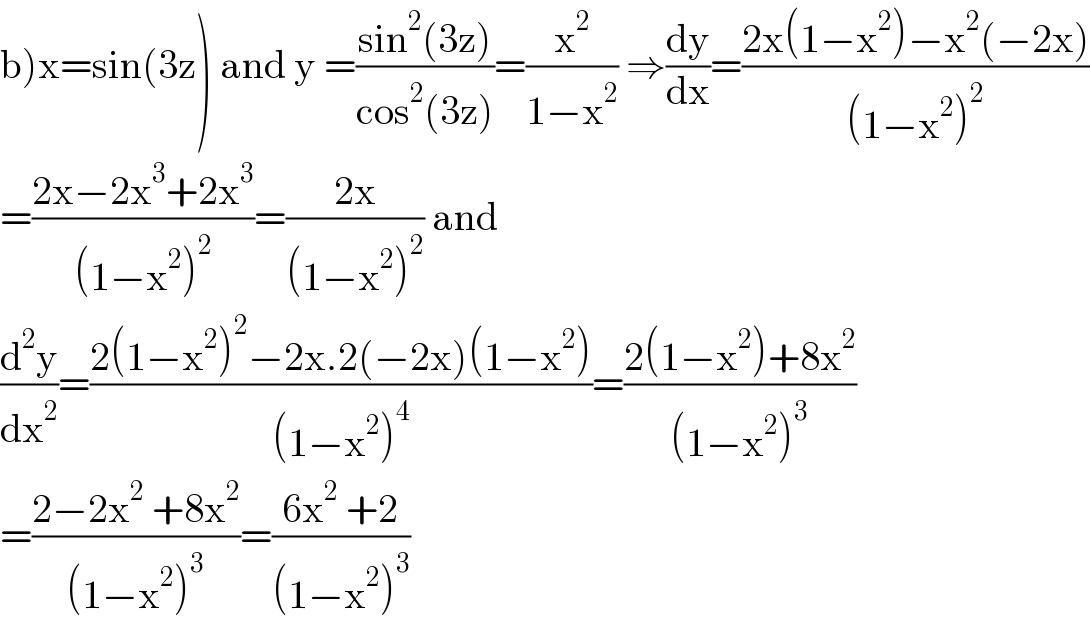
Question Number 134511 by mohammad17 last updated on 04/Mar/21

Commented by mohammad17 last updated on 04/Mar/21

$${how}\:{can}\:{solve}\:{this} \\ $$
Commented by mohammad17 last updated on 04/Mar/21

$$?????? \\ $$
Commented by mohammad17 last updated on 04/Mar/21

$${i}\:{want}\:{question}\left(\mathrm{2}\right)\:{A}\:{please} \\ $$
Commented by mr W last updated on 04/Mar/21

$${distance}\:{from}\:{the}\:{point}\:\left({u},{v}\right)\:{to}\:{line} \\ $$$${ac}+{by}+{c}=\mathrm{0}\:{is} \\ $$$${d}=\frac{\mid{au}+{bv}+{c}\mid}{\:\sqrt{{a}^{\mathrm{2}} +{b}^{\mathrm{2}} }} \\ $$
Commented by Dwaipayan Shikari last updated on 06/Mar/21

$${d}=\frac{\mid−\mathrm{8}−\mathrm{2}−\mathrm{5}\mid}{\:\sqrt{\mathrm{4}+\mathrm{1}}}=\mathrm{3}\sqrt{\mathrm{5}} \\ $$
Answered by mathmax by abdo last updated on 06/Mar/21

$$\left.\mathrm{a}\right)\:\mathrm{d}=\frac{\mid\mathrm{2x}_{\mathrm{0}} −\mathrm{y}_{\mathrm{0}} −\mathrm{5}\mid}{\:\sqrt{\mathrm{2}^{\mathrm{2}} +\left(−\mathrm{1}\right)^{\mathrm{2}} }}=\frac{\mid−\mathrm{8}−\mathrm{2}−\mathrm{5}\mid}{\:\sqrt{\mathrm{5}}}=\frac{\mathrm{15}}{\:\sqrt{\mathrm{5}}} \\ $$
Answered by mathmax by abdo last updated on 06/Mar/21

$$\left.\mathrm{b}\right)\mathrm{x}=\mathrm{sin}\left(\mathrm{3z}\right)\:\mathrm{and}\:\mathrm{y}\:=\frac{\mathrm{sin}^{\mathrm{2}} \left(\mathrm{3z}\right)}{\mathrm{cos}^{\mathrm{2}} \left(\mathrm{3z}\right)}=\frac{\mathrm{x}^{\mathrm{2}} }{\mathrm{1}−\mathrm{x}^{\mathrm{2}} }\:\Rightarrow\frac{\mathrm{dy}}{\mathrm{dx}}=\frac{\mathrm{2x}\left(\mathrm{1}−\mathrm{x}^{\mathrm{2}} \right)−\mathrm{x}^{\mathrm{2}} \left(−\mathrm{2x}\right)}{\left(\mathrm{1}−\mathrm{x}^{\mathrm{2}} \right)^{\mathrm{2}} } \\ $$$$=\frac{\mathrm{2x}−\mathrm{2x}^{\mathrm{3}} +\mathrm{2x}^{\mathrm{3}} }{\left(\mathrm{1}−\mathrm{x}^{\mathrm{2}} \right)^{\mathrm{2}} }=\frac{\mathrm{2x}}{\left(\mathrm{1}−\mathrm{x}^{\mathrm{2}} \right)^{\mathrm{2}} }\:\mathrm{and} \\ $$$$\frac{\mathrm{d}^{\mathrm{2}} \mathrm{y}}{\mathrm{dx}^{\mathrm{2}} }=\frac{\mathrm{2}\left(\mathrm{1}−\mathrm{x}^{\mathrm{2}} \right)^{\mathrm{2}} −\mathrm{2x}.\mathrm{2}\left(−\mathrm{2x}\right)\left(\mathrm{1}−\mathrm{x}^{\mathrm{2}} \right)}{\left(\mathrm{1}−\mathrm{x}^{\mathrm{2}} \right)^{\mathrm{4}} }=\frac{\mathrm{2}\left(\mathrm{1}−\mathrm{x}^{\mathrm{2}} \right)+\mathrm{8x}^{\mathrm{2}} }{\left(\mathrm{1}−\mathrm{x}^{\mathrm{2}} \right)^{\mathrm{3}} } \\ $$$$=\frac{\mathrm{2}−\mathrm{2x}^{\mathrm{2}} \:+\mathrm{8x}^{\mathrm{2}} }{\left(\mathrm{1}−\mathrm{x}^{\mathrm{2}} \right)^{\mathrm{3}} }=\frac{\mathrm{6x}^{\mathrm{2}} \:+\mathrm{2}}{\left(\mathrm{1}−\mathrm{x}^{\mathrm{2}} \right)^{\mathrm{3}} } \\ $$
